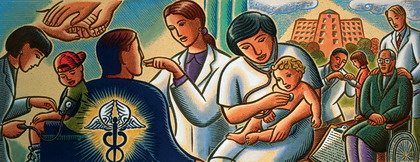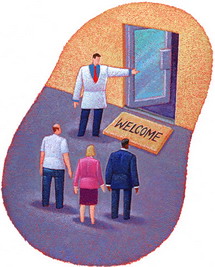For the past three years, I have had a chance to dig heavily into the future, and I’m pretty convinced that the old saying, “Necessity is the mother of invention,” has never been more true than in today’s healthcare environment. What was a given before in healthcare management may no longer be so in the future, and since most hospitals only Chief Innovation Officer is the President him or herself, their tasks of visualizing, understanding, deciding and directing the future of the organization will be shifting even more heavily from quantitative deciding-and-directing to the more qualitative visualizing-and-understanding side of this leadership equation.
Although I understand the reluctance of most CEO’s to be on the bleeding edge of creativity, my experiences at my former positions can significantly reduce or mitigate the majority of risk from any decision regarding innovation.
Our new competitive environment has an insatiable appetite for information, access and connectivity and it’s a well known fact that a periodic injection of chaos fosters creativity and forces your co-workers to leverage technology. Because most organizations already have an environment that is built on trust and collaboration, injecting a little creativity can put their CEOs in more of a position to be the orchestrator and the inspirer.
 That Used to be Us is the new book by Thomas Friedman and Michael Mandelbaum in which they analyze four specific challenges Americans face as a nation—globalization, the revolution in information technology, the nation’s chronic deficits, and our pattern of excessive energy consumption—and spell out what they believe needs to be done to sustain the American dream, and achieve true supremacy based on innovation and excellence.
That Used to be Us is the new book by Thomas Friedman and Michael Mandelbaum in which they analyze four specific challenges Americans face as a nation—globalization, the revolution in information technology, the nation’s chronic deficits, and our pattern of excessive energy consumption—and spell out what they believe needs to be done to sustain the American dream, and achieve true supremacy based on innovation and excellence.
As an innovator and futurist, several sections of this book captured my imagination and brought closure to a myriad of beliefs that I have instinctively embraced over the past few decades. When my responsibilities revolved around the CEO position, I always saw my job as being a contributor to an environment where creative decisions were embraced allowed to happen and then those innovators were rewarded and inspired to keep going.
As the co-founder of a Research Institute, one issue that continually resonates with me is that “We don’t have enough ‘rogue’ CEO’s in healthcare administration to take risks so that the rest can benefit from both their successes and knowledge.”
Well, fortunately, I’m your guy.
For the last several years I have been out there implementing unusual things, and many of these disruptive ideas are coming to pass in a big way. I was the first hospital CEO to blog, starting in 2005 (HealingHospitals.com), was an early Planetree board member, created the first breast cancer research center dedicated to the Department of Defense, and filled my hospital with Integrative Medicine, hotel amenities, and music.
Below, I’ve listed thirteen new examples of areas of innovation, in which we’ve been working for the past three years, as well as numerous ways to pay for these initiatives.
Thirteen Examples of Disruptive Technologies and Practices That Hospitals Need to Understand
- Robotic algorithmic software that improves emergency room flow by 37 to 50 percent.
- Financial transaction software that reduces electronic transfer fees exponentially (25% of health care income is from electronic transfers.)
- Utilization of nurses and actuaries as patient advocates to significantly reduce your employee health costs.
- Preventative medicine reimbursements that can double a physician’s income and add bottom line profits to hospitals.
- Treble growth potential of your organization through adding Integrative Medicine
- Diabetic retinopathy telemedicine for Family and Internal Medicine docs.
- Proteomic and genomic testing creating new “hospital income.”
- Peritoneal lavage that extends Stage 4 cancer patients from three months to five years or more.
- Bone scaffolding that supports bone growth and virtually eliminates bone infection.
- Special bandages that protect and stem cell cocktail sprays that heal burn wounds
- Access to a cancer consortium that allows small and medium hospitals to become Certified Cancer Centers
- Hospitals paid “not to play” during an energy crisis as a back-up to the power grid.
- Green hazardous waste disposal costing 25% less than traditional methods
If you’d like to learn more about any adopting any of the concepts above, or receive a leadership presentation that will enable your staff to see the opportunities (rather than just the threats) in our current, uncertain environment, here’s where to find me.
Why Are Hospitals The Way They Are? from Nick Jacobs, FACHE on Vimeo.



 He then challenged the other Boston hospitals to do the same. He was accused of self-aggrandizement, egomania, and numerous other witchcraft-like things, but the bottom line was that the number of infections went down, and they went down because the staff and employees wanted to do better and wanted them to go down.
He then challenged the other Boston hospitals to do the same. He was accused of self-aggrandizement, egomania, and numerous other witchcraft-like things, but the bottom line was that the number of infections went down, and they went down because the staff and employees wanted to do better and wanted them to go down.




 The cost? In the big picture, the cost is not even a consideration. Your investment now is less than you can imagine, as your facilities grow, expand, and thrive. Besides:
The cost? In the big picture, the cost is not even a consideration. Your investment now is less than you can imagine, as your facilities grow, expand, and thrive. Besides:
 These are just a few of the very effective mechanism that can be introduced to create
These are just a few of the very effective mechanism that can be introduced to create 


